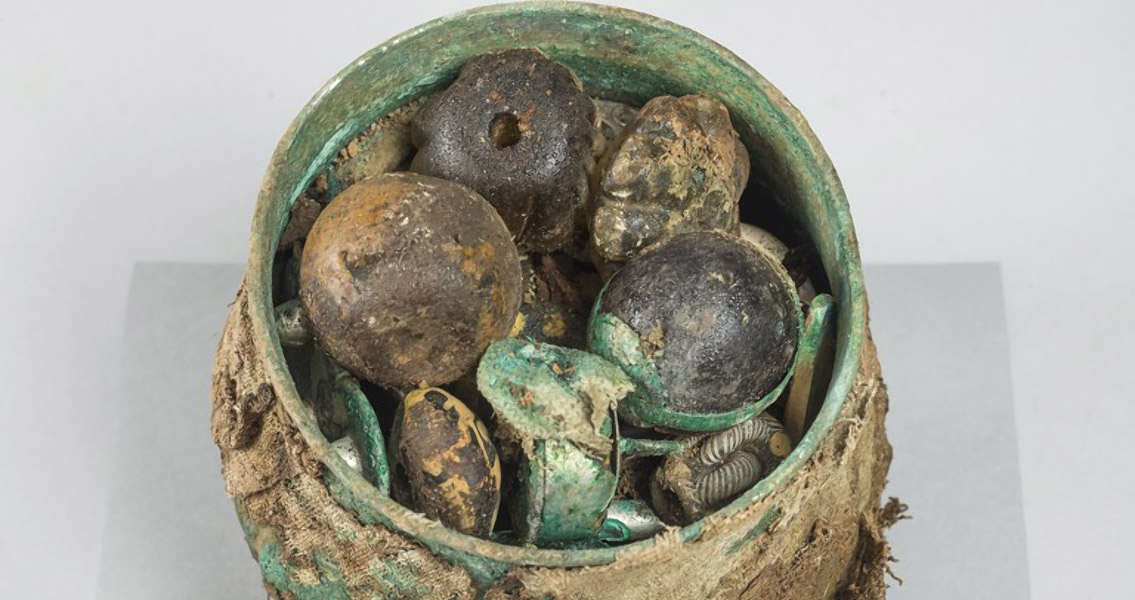<![CDATA[After 18 months of painstaking work; removing and preserving the treasure trove of items which had been so carefully packed into the metal vessel, conservationists have released images of and details about the Viking treasure trove discovered in the Galloway region of Scotland in 2014. The hoard is nothing less than stunning; six silver Anglo-Saxon disc brooches, silver armbands, a silver brooch from Ireland, Byzantium silk, gold and silver ingots and various crystal and gold objects which had been carefully bundled in cloth, among other items. The metal vessel containing the treasure was fashioned from a silver/copper alloy by metalworkers from the Carolingian empire and is an important and rare find in and of itself. The Carolingian empire stretched from Germany to France and was ruled by Charlemagne at one time. To date, only six Carolingian vessels (or pots) have ever been discovered and many experts believe they may have been used by the Catholic Church at important ceremonies. This has led some researchers to speculate the vessel could be plunder from a wealthy monastery raided by the Vikings. The items, approximately 100 of them, date from the ninth century to the tenth century CE. Ancient texts date the Vikings arrival to the British Isles during the 790s CE, when vicious raiders suddenly appeared along European coasts and proceeded to plunder rich monasteries and terrorize local villages. In the following three centuries ambitious Viking rulers arrived to colonize and conquer territories in Ireland, England, Scotland and Wales, until they were eventually defeated or more likely assimilated by the population. Intrigued by Viking folklore in the Galloway region, Derek McClennan set out with a small group of friends and his metal detector on September 1, 2014 to investigate and search for any traces of the Vikings. What he found, among other things, was a large silver cross and a silver armband bearing a Viking design. He immediately contacted authorities, who in turn quickly dispatched an archaeologist with the Dumfries and Galloway Council to the site. The archaeological excavation discovered not just one treasure trove, but two. In the top layer, archaeologists excavated over 60 silver ingots, a bird-shaped gold pin, and armbands, many of which were made by Irish metalworkers. This type of portable silver was used as ready cash by the Vikings. They would break off pieces to purchase cattle and other goods, pay troops or reward loyal followers. Three inches (eight centimeters) below this cache, researchers found the large metal vessel which had been buried upside down, possibly to seal it against ground water. It was packed with treasures, many of them wrapped in fine textiles or leather. Exactly how the Viking owner came to possess all the treasure and why they buried it remain provocative questions. Stuart Campbell of the Treasure Trove Unit, told the BBC, "The complexity of the material in the hoard raises more questions than it answers, and like all the best archaeology, this find doesn't give any easy answers. Questions about the motivations and cultural identity of the individuals who buried it will occupy scholars and researchers for years to come." Scottish law for recovered treasure does dictate a reward be made to the finder. The Church of Scotland (the landowners), and McLennan will be sharing any proceeds. The conservation project is being funded by Historic Environment Scotland, working in partnership with the Treasure Trove Unit, and the Queen's and Lord Treasurer's Remembrancer. The contents are currently being held by the Treasure Trove Unit, who are tasked with assessing the collection’s value. Images of the artifacts can be found here: here Featured Image courtesy of Historic Scotland]]>
Revealed: Images of Scottish Viking Treasure Trove
